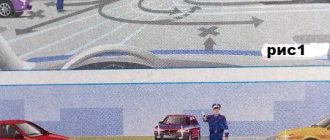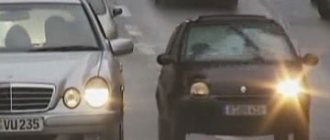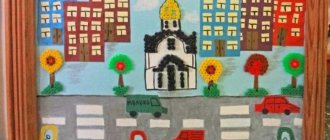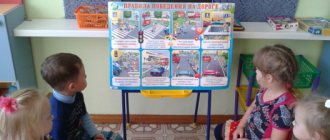Parents - about road safety
Dear parents!
Who among you does not want to see your child healthy and unharmed? And everyone thinks that their smart and sensible little one will definitely not end up under the wheels of a car. But sometimes it’s not easy for a child to avoid a traffic accident. Of course, each incident on the road is unique in its own way. But there are so many of them, these tragedies on the road!
Every year, two classes of children die on the roads and about 500 are injured of varying degrees of severity, which are extremely dangerous. Basically, these are traumatic brain injuries in combination with severe injuries to the thoracic and abdominal organs, and fractures of the limbs. Injuries sustained as a result of a vehicle hitting a child are especially serious. The fact is that such an injury is “double”: first, a car hits a person, knocks him over onto the hood, and then his body falls onto the roadway. The result is two strikes! Moreover, it is the second blow that is more dangerous, because when children fall, they most often hit their head (the ratio of the weight of the head to the total body weight of a child is greater than that of an adult). Injuries can also be severe when hitting sharp corners, as well as rigid vehicle structures. The consequences of auto injuries, most often, leave physical injuries and moral and psychological shocks for life, and do not always manifest themselves immediately. On average, each child with a car injury spends about two months in a hospital bed, and the rehabilitation period is 8-10 years.
A road traffic accident is a tragedy, in which case the child’s “personal” experience is unacceptable and must be replaced by the experience accumulated by society. Therefore, it is so important to teach children how to behave on the street, taking into account their psychological and physiological characteristics.
Psychologists have long established that children, due to their age-related psychological characteristics, cannot always correctly assess the instantly changing situation on the road, and often overestimate their capabilities. Sometimes they simply repeat what adults do in such cases. Yes, adults are trying to cross the street. And they run across (though not always successfully), which is helped by the ability to estimate the distance to the car and assess the situation on the road. But these are adults, and what about children? The child's body is in a state of formation. Many processes are mobile and unstable. Hence the different reactions of children and adults to the same road situations.
Special studies have established that children cross the road differently than adults. Adults, approaching the roadway, observe from afar and assess the current situation. Children begin observing only when they approach the edge of the road or are already on it. As a result, the child’s brain does not have time to “digest” the information and give the correct command to action. In addition, young children transfer their ideas from the microworld of toys into the real world. For example, the belief that real vehicles can actually stop in place just as instantly as toy vehicles.
The growth of a child is a serious obstacle to viewing the surrounding environment: due to standing vehicles, he cannot see what is happening on the road, while at the same time he himself is not visible to drivers because of the cars. A child may not hear the sound of an approaching car or other signal, not because he does not know how to distinguish them, but because he lacks constant attention. Children's attention is selective and concentrates not on objects that pose a danger, but on those that currently interest him most, and the speed of perception of a sound signal in children is much greater than in adults. Children have a shorter step and a smaller field of view by 15-20%, and a slower reaction to danger (3-4 seconds instead of 0.8-1 in adults). The assessment of moving vehicles is influenced by contrasts. The larger the size of the vehicle, the more significant its difference in color and sound from its surroundings, the faster children imagine its movement, and therefore react differently. When a large truck approaches, even if it is moving at high speed, the child is less likely to risk crossing the roadway, but underestimates the danger of a small passenger car approaching at high speed.
Children are highly influenced by emotions. Joy, surprise, interest in something make you completely forget about the danger to which they may be exposed. Even differences in temperament influence the behavior of children on the road. This is clearly evident in the style of crossing the road.
So, for example, in a choleric child with his inherent “intolerance”, when there is, from his point of view, a long delay when crossing the road, and if the “right” bus, tram or someone he knows is standing on the opposite side, a specific feeling often arises. a state of emotional discomfort, since such a delay clearly contradicts its psychophysical essence. The child strives to interrupt such a delay even at the expense of increasing risk. He begins to maneuver between cars or cross the road in front of nearby vehicles.
A child with a melancholic type of temperament, who gets lost in difficult situations, begins the transition in a mode of mental stress. And if we consider that he has to cross the roadway several times during the day, then excessive mental stress, irritation, fatigue gradually accumulate and, ultimately, a feeling of fear arises. Therefore, every parent should be well aware of the temperamental characteristics of their child in order to take them into account when teaching safe behavior skills on the road.
Often children have great difficulty in giving a correct assessment of the traffic situation they see and are not able to quickly make decisions or balance the speed of the car with the distance at which the car is located from it. They are not yet able to predict all possible driver behavior. Moreover, in an extreme situation, and in general in cases where a child is faced with an urgent choice: what to do, he easily falls into a state of hopeless danger, insecurity, he is simply lost.
The more difficult the situation is for the child, and the more intelligence and speed he needs to show in making decisions, the more inhibition develops in the child’s central nervous system. And thus, a vicious circle develops: the more dangerous the situation, the slower and more incorrect the child makes decisions.
Is it possible to do something to make the right decision on the road correctly and on time and avoid serious consequences? What should a driver do in a difficult situation on the road, and what should a pedestrian do? Alas, most often people think about this only when the fact of a traffic accident has happened. And only then they analyze: “Was there a way out?” And the victims themselves give a lot of options in which they could have avoided the tragedy.
We all learn the Rules of the Road in a “refined” form, i.e. perfect form. But in life, we often see something completely different. It turns out that pedestrians can cross the road at a red traffic light, and sometimes drivers do not shun this: they can drive through a red light, they can even refuse to let a pedestrian pass at a pedestrian crossing... And how many drivers are detained every day by traffic police officers in a drunken state, and increasingly in narcotic! Drunk pedestrians often get into traffic accidents.
But let’s not talk about such things that are fundamentally incompatible with the road, such as alcohol and drugs. Let's talk about basic advice for disciplined road users: how to avoid accidents. These tips, by the way, are acceptable for both pedestrians and drivers.
Three "laws" of road safety
- "Law" of traffic safety
“The higher the speed, the greater the danger.
The higher the danger, the lower the speed and the greater the caution."
The choice of permissible safe speed depends on a number of conditions: road condition, visibility range, visibility, intensity and nature of traffic, the design and technical condition of vehicles, as well as the type of cargo being transported. Of these, the most important conditions for road safety are: visibility and visibility. Visibility is the ability to distinguish details of the road situation. It depends on weather conditions, lighting, and the degree of contrast of the roadway in relation to other elements of the road. Visibility is the ability to observe the roadway and road conditions on the sides and in front of you, i.e. absence of various obstacles on the road in a person’s field of vision. This is no less important for a pedestrian than for a driver. No wonder the first rule of a pedestrian is to cross the road where it is clearly visible in both directions!
- "Law" of traffic safety
The “dark basement” rule: if you don’t see it, stop or sharply reduce speed.
Imagine that you are entering a completely dark room from the street, for example, a basement. Further, if this room is not familiar to the person entering, then his actions will be as follows: he will either stop, or slow down, and wait until his eyes get used to the darkness. At best, he will walk, but very slowly, constantly looking forward and to the sides, or by touch, sneaking. This happens because there may be an unforeseen danger ahead - a “trap”.
It’s the same on the road: in a difficult situation, especially with insufficient visibility and visibility, remember about the “dark basement” and this association, or rather the internal signal “Stop! Danger! ”, will protect you from road “traps”.
- "Law" of traffic safety
“Feel the road”, be able to see, observe and anticipate.
Proceed Safely!
Have you ever wondered why some people never have an accident, while others just have bad luck all the time? Yes, we have undisciplined drivers and pedestrians. But it's not only that. It is important to foresee a dangerous traffic situation - a “trap”. All over the world, “defensive driving” technology is used, when the driver takes into account the possibility of mistakes of other road users, anticipates them and compensates for them, i.e. smooths out and corrects the traffic situation with its proactive actions. But not only drivers, but also pedestrians should act this way.
To protect yourself, you must be able to anticipate possible mistakes of other road users and be ready to prevent and compensate for these mistakes with your counter actions. Be prepared for the fact that another car may drive out from behind a stationary car, that a moving bus may hide another vehicle behind it, that an undisciplined driver may not let you pass at a pedestrian crossing, and that vehicles on a slippery road may not immediately after pressing the brake pedal. Be careful in places with limited visibility, and it will be much easier for you to act in difficult situations that arise.
Sometimes they ask the question: “What traffic rules does a first-grader need to know, and what does a high school student need to know?” Both need to know everything that relates to pedestrian safety on the road. Children should be taught not so much the Rules as how to analyze the occurrence of dangers on the road. It's like a vaccination that increases immunity, only at the mental level.
And no matter what type of temperament dominates in your child, it is necessary that when approaching the roadway, he should be able to tune in to the transition. And for this it is necessary to eliminate haste and fuss.
It often happens that a child, having received a bad grade and leaving school, cannot switch, having already tuned in to an unpleasant conversation at home. Therefore, try not to punish him too harshly, react to failure very diplomatically.
Pay special attention to children with visual and hearing impairments. In winter, draw children's attention to snow curbs along the roads. There is no need to stand on them, because it is very easy to slip under the wheels of passing cars. Even the flow of air from passing vehicles can carry a child along with it.
A child's clothing is also important for road safety. A hood, a winter hat, and tightly wrapped scarves constrain and limit movement, impair hearing, and make it difficult to turn the head. We need to remember this when wrapping up a child, and remind him that when crossing the roadway, he needs to repeatedly assess the situation. In addition, we recommend purchasing clothes and accessories for children with reflective elements that will make your child visible in the evening, at night and in conditions of poor visibility.
Summer time also has its own characteristics. Firstly, the number of vehicles is increasing significantly, because those drivers who have not used a car in winter are driving on the roads, and their driving skills have naturally weakened. Finally, motorcycles appear on the road - pedestrians have completely lost the habit of them over the winter period. The child needs to be shown how unexpectedly these vehicles appear from behind buses and cars, creating a threat to pedestrians.
If you bought a bicycle for your child, you need to explain to him the rules for using it on the road. The child must learn that riding a bicycle can only be done in specially designated places - courtyards, parks, public gardens, stadiums. It is also necessary to tell him about the mistakes of cyclists that lead to accidents. Children under 14 years of age are generally prohibited from riding bicycles on public roads. You should not place your child on the frame or rack while riding your bike. To do this, the bicycle must be equipped with a special seat and footrests.
When teaching your child the Rules of the Road, do not forget to show him those violations that can be seen on the streets among drivers, so that when crossing roads and intersections, the little pedestrian learns to take compensatory actions in relation to other road users, i.e. Cultivate the instinct of self-preservation in your child. Show him the pedestrian offenders. And, moreover , never violate traffic rules yourself . From the child's point of view, parents are a model of behavior, and everything that mom and dad do is excellent. It is later, with age, that the ability to critically evaluate actions and their results will come. For children, parents are only an object of love and imitation. If it’s possible with mom or dad, then it’s possible at all. If nothing happened when you crossed the road with your dad or mom, then nothing will ever happen. If dad or mom did this, then it should always be done this way. By breaking the rules, parents lay the foundation for a future tragedy.
Your personal example of compliance with traffic rules will help to form a strong habit of not violating traffic rules, bringing the child’s correct actions when crossing the road to automatism . Do not remain indifferent to the behavior of strangers, not your children, on the road . Perhaps a remark you made to your child, a helping hand extended in time, will prevent a possible disaster.
Feeding, clothing the baby, aiming for good grades is not the main thing. It is necessary that with all these worries, the most important thing is not forgotten - the road: the road to school, the road home. It is important that it leads to the goal and does not break off at the beginning or halfway. And if one day, going to work, you hear instructions from a child about attentiveness addressed to you, it means that your work was not in vain. Your child will be alive and well!
But that is not all. We must not forget about responsibility for our minor children, because of whose careless behavior, and sometimes quite deliberate violation of traffic rules, an accident may occur. Only an adult citizen can independently and fully exercise his rights and obligations. The Constitution defines the age of majority and legal capacity at 18 years. In accordance with the Civil Code, it is the parents who are civil defendants and bear financial responsibility for damage caused by the criminal actions of their child.
In accordance with Article 1074 of the Civil Code of the Russian Federation, a minor accused between the ages of 14 and 18 years is independently responsible for the harm caused on a general basis. But if he does not have income or other property sufficient to compensate for the harm, this harm can be compensated by his parents, who are involved in the case as civil defendants. Thus, if, due to the fault of your child, an accident was committed in which people were injured and a car was broken, then you, dear parents, will have to answer according to the Law!
Summary of the parent meeting on the topic “Children’s safety on the road”
Author: Kruglikova Olga Stepanovna
Summary of the parent meeting in the preparatory group
Parent meeting in the preparatory group on the topic “Children’s safety on the road.”
Author: Olga Stepanovna Kruglikova, teacher at MBDOU No. 90, Kemerovo.
Target:
Pedagogical education and involvement of parents in the process of teaching preschoolers the skills of safe behavior on the roads and streets of the city, developing a sense of responsibility for the life and health of their children.
Tasks:
— Familiarize parents with the theoretical foundations of road safety. — To create motivation in parents to self-develop a culture of safe behavior for children on the streets and roads. — Create conditions for interaction with society to prevent road traffic injuries among preschool children.
Parent meeting agenda:
1. Opening remarks. 2. Message from the group teacher. 3. Recommendations for parents on teaching children traffic rules.
4. Distributing a handout for parents “What can I do?”
Progress of the parent meeting:
1. Opening speech by the teacher:
“Our children were born to live joyfully. To play together, to be strong friends, to give smiles to each other and flowers, so that dreams always come true in their lives.”
Yes, our children are born precisely for this, but whether this always happens, whether life will be overshadowed by tragedy - this largely depends on us, adults. The topic of today's meeting is “Children's safety on the road.” The need for a meeting on traffic rules is dictated by life itself. The terrible statistics of child mortality and health damage as a result of road accidents are simply terrifying. And most often we, the adults, are to blame for tragedies. At this meeting we will talk about what parents can do to keep their child safe on the road. First of all, parents should understand that this task of protecting their child on the road is fundamentally unsolvable. Firstly, any movement by transport (and even on your own feet) is associated with danger, and the probability of the unexpected happening is always different from zero. This was not said at all to scare parents, but on the contrary, to draw their attention to the fact that you should always take care of the children’s safety (and your own). Secondly, the task of protecting the child once and for all cannot be solved, because the child is growing, and the possible dangers that await him on the road are growing. Therefore, children should be promptly taught the ability to navigate a traffic situation, cultivate the need to be disciplined on the street, careful and prudent. And parents should not make the most common mistake - acting on the principle “you can do it with me.” If you show your child by your own example how to run to red, be sure that when left alone, he will try to repeat this trick. Dear parents! Remember, if you break the Rules, your child will do the same! We have the power to develop the skills of safe behavior on the roads, to educate a conscious and competent pedestrian, responsible for the life and health of road users.
2. Message from the group teacher.
Today's children have to live with incomparably more aggressive traffic, and therefore every day it is becoming more and more difficult to ensure their safety. It is very important from preschool age to develop in children the skills of safe behavior on the road and to raise law-abiding citizens. Our task is to develop in children an understanding of the dangers that the automotive world conceals. It is important to do this before the child adopts and accepts the wrong stereotypes of behavior on the road, which, unfortunately, are currently prevalent in the adult environment. The study of traffic rules in kindergarten takes place in special classes, during games (didactic, active, role-playing), entertainment, etc. The topic of traffic rules covers not only educational, but also other types of classes - mathematics, familiarization with fiction, arts and crafts, physical education, etc. In classes, children learn to navigate in space, simulate various situations on the road, and play them out. We also form motor skills in children: children must not only move correctly in accordance with the received signal or, focusing on an adult, but also be able to coordinate their movements with the movement of other people and the movement of objects. In addition, with the help of didactic games we try to develop voluntary, active attention, because For safe behavior on the streets, it is necessary to develop in children voluntary attention and the ability to concentrate on the road situation. Preschool children are a special category of pedestrians and passengers. They cannot be approached with the same standards as adults, so there is a need to create a certain system to familiarize children with traffic rules and instill in them the skills of safe behavior on the roads and streets of various settlements. It is safe to say that work in this area is being carried out quite effectively, since for several years now no violations or accidents involving pupils of our kindergarten have been recorded. Our goal is not only to give children knowledge about the rules of the road, but also to develop in them the skills to adequately apply this knowledge in various situations, so that these skills develop into a habit.
3. Recommendations for parents on teaching children traffic rules.
Let me remind you once again of the basic rules that a child should know:
1. Basic terms and concepts of the rules. 2. Responsibilities of pedestrians. 3. Responsibilities of passengers. 4. Traffic regulation. 5. Traffic lights. 6. Warning signals. 7. Traffic across railway tracks. 8. Traffic in residential areas and transportation of people. 9. Features of cycling.
Remember! The child learns the laws of the roads, following the example of family members and other adults. Don't waste time teaching your children how to behave on the road. To prevent your child from creating a dangerous situation on the roads, he must be able to: • watch the road; • correctly assess the road situation in all its variability; • see, listen, anticipate, avoid danger.
Watch the road.
1. It is necessary to teach children not only to follow the traffic rules, but also from a very early age to teach them to observe and navigate. It must be taken into account that the main way to develop behavioral skills is through observation and imitation of adults, especially parents. 2. When you are on the roadway with your child, do not rush, cross the road at a measured pace. Otherwise, you will learn to rush where you need to watch and ensure safety. 3. Teach your child to notice a car. Sometimes a child does not notice a car from afar. Teach him to peer into the distance. 4. Teach your child to estimate the speed and direction of the future movement of the car. Teach your child to determine which one is going straight and which one is preparing to turn. 5. Teach your child to watch. The habit of inspecting the street in both directions should be brought to automaticity before taking the first step from the sidewalk to the roadway. You need to look especially carefully at the street when there is a family home or acquaintance on the opposite side, or when a child crosses the street with other children - it is in these cases that it is easy to miss the car.
Correctly assess the road situation.
The main danger is a stationary car. Why? Yes, because having seen the approaching car in advance, the pedestrian will give way to it. A stationary car deceives: it can block a moving one, preventing you from noticing the danger in time.
Rule #1.
You cannot go out onto the road because of parked cars. As a last resort, you need to carefully look out from behind a standing car, make sure that there is no danger, and only then cross the street. Watch with your child the cars standing at the edge of the roadway and pay attention to the moment when another one suddenly appears from behind the standing car. Draw your child's attention to the fact that a bus standing at a stop also makes it difficult to see the car moving behind it.
Rule #2
You need a parked bus neither in front nor behind! A standing bus, no matter how you go around it - in front or behind, covers a section of the road along which a car can pass at the moment when you decide to cross it. In addition, people near the bus stop are usually in a hurry and forget about safety. We have to wait until the bus leaves.
Rule #3
And at the traffic lights you can meet danger! Children often reason like this: “The cars are still standing, the drivers see me and will let me through.” They are wrong. Immediately after turning on the green signal for drivers, a car that was not visible behind the standing cars and whose driver cannot see the pedestrian may enter the crossing. If the green traffic light for pedestrians goes out, you need to stop. The child must not only wait for the right light, but also make sure that all the cars have stopped.
Rule #4
Develop in your child the habit of always stopping, looking around, listening before going out on the road, even if there are no cars on it, and only then cross the street.
Rule #5
Strong transport behavior skills in children are formed only through daily systematic training! During every walk with children, trips with them on business, to visit, out of town, etc. teach them to observe the street and transport, analyze the road situations encountered, see dangerous elements in them, and act accurately in various circumstances.
Rule #6
There is no need to instill in children an excessive sense of fear of traffic and moving cars. Let everything that is connected with kindergarten (and later school), including the road, be associated with the bright and kind in the child. At the same time, you need to teach him to be attentive, and this is not an easy thing. The processes of perception, attention and reaction in a child and an adult are completely different. Experienced drivers know, for example, that sounding the horn when they see a child running across the road is dangerous. The child may act unpredictably - instead of stopping, he may rush without looking back under the wheels of another car. Even those children who know the rules of the road sometimes break them. Don't take the trouble to help the children. You may have to stop a child who doesn't want to wait for a traffic light. Do it kindly.
4. Distribute reminders for parents “What can I do?”
Memo “What can I do?” (Appendix No. 1) will tell you what parents can do to keep their child safe on the road.
So, if you teach your children to follow these basic rules of behavior on the roads, then trouble will not come to your home.
In conclusion, it is worth noting that studying traffic rules is just as necessary as studying basic subjects (mathematics, Russian language). After all, the safety of our children’s lives is no less important than the indicator of their intellectual development, and even much more significant. When teaching a child the rules of the road, an adult must clearly understand what needs to be taught and how to do it more effectively. He himself must be well versed in road situations. Therefore, you should not only analyze your life experience in advance, but also study the necessary literature on the topic “Road Rules”. What and, most importantly, how well we teach a child, what skills of safe behavior on the street we instill in him, will protect him all his life. Attached files: comments powered by HyperComments





